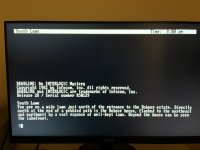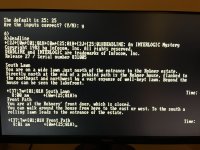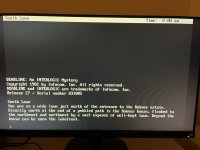Hi everyone!
I recently got enough of the various parts for my XT build to be able to install my XT-CF-Lite 4.1 card and PC-DOS 3.30 to it and, you know, get it to run to do anything other than BASIC. I went through the XUB update relatively smoothly (the card was supplied with an early 2013 build of XUB, for unknown reasons) and everything seems to work as fine as would be reasonable to expect when displaying the CGA graphics via composite cable to my non-NTSC monitor.
However, I've run into one strange problem.
I decided to load up an Infocom game to test the mettle of my 256k XT, settling on the classic mystery game DEADLINE.
I first ran it through the DOS-version of the Z-code interpreter Frotz. It went well enough, as can be seen below (as long as I added -d2 to the command instruction, for CGA graphics mode, anything else and it would crash back to DOS).

Only problem is: being written for much more modern machines, Frotz runs incredibly slow.
"Oh well", thought I, "let me instead get the original DOS version of the game and play that!"
After finding that most Abandonware sites and such had copies of the game that were really just zip-files with a Z-code file and a Frotz interpreter, I eventually found an image file of an original DOS floppy version of the game on archive.org. Hooray!
I unpacked the image file, copied the files over to a 720k floppy disk, put the disk in my XT and fired it up. However, this is what I got:

Thinking there might be something wrong with the game files on the floppy image, I ran the very same game in DOSbox. This time, it went flawlessly, as can be seen below:

What gives?
Further notes:
* There is a SETUP.EXE file shipped with the floppy image. The first time I tried it on my XT, I didn't run it beforehand. When the problem became evident (as seen in picture 2), I ran the setup file, which only asked me to specify number of columns and lines, respectively, on my computer (which I did, though it was already set for 80 by 25), and made nothing different.
* I thought that maybe I had picked the wrong display boot settings in the XUB configuration, but I ran through all the 80x25 options there (mono, black and white, default, etc) with no more luck when trying to play the game.
I recently got enough of the various parts for my XT build to be able to install my XT-CF-Lite 4.1 card and PC-DOS 3.30 to it and, you know, get it to run to do anything other than BASIC. I went through the XUB update relatively smoothly (the card was supplied with an early 2013 build of XUB, for unknown reasons) and everything seems to work as fine as would be reasonable to expect when displaying the CGA graphics via composite cable to my non-NTSC monitor.
However, I've run into one strange problem.
I decided to load up an Infocom game to test the mettle of my 256k XT, settling on the classic mystery game DEADLINE.
I first ran it through the DOS-version of the Z-code interpreter Frotz. It went well enough, as can be seen below (as long as I added -d2 to the command instruction, for CGA graphics mode, anything else and it would crash back to DOS).

Only problem is: being written for much more modern machines, Frotz runs incredibly slow.
"Oh well", thought I, "let me instead get the original DOS version of the game and play that!"
After finding that most Abandonware sites and such had copies of the game that were really just zip-files with a Z-code file and a Frotz interpreter, I eventually found an image file of an original DOS floppy version of the game on archive.org. Hooray!
I unpacked the image file, copied the files over to a 720k floppy disk, put the disk in my XT and fired it up. However, this is what I got:

Thinking there might be something wrong with the game files on the floppy image, I ran the very same game in DOSbox. This time, it went flawlessly, as can be seen below:

What gives?
Further notes:
* There is a SETUP.EXE file shipped with the floppy image. The first time I tried it on my XT, I didn't run it beforehand. When the problem became evident (as seen in picture 2), I ran the setup file, which only asked me to specify number of columns and lines, respectively, on my computer (which I did, though it was already set for 80 by 25), and made nothing different.
* I thought that maybe I had picked the wrong display boot settings in the XUB configuration, but I ran through all the 80x25 options there (mono, black and white, default, etc) with no more luck when trying to play the game.
